

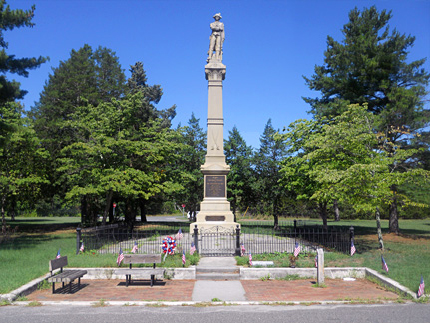
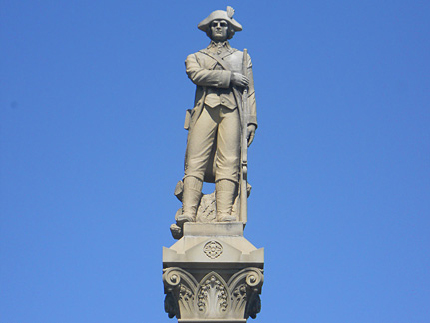
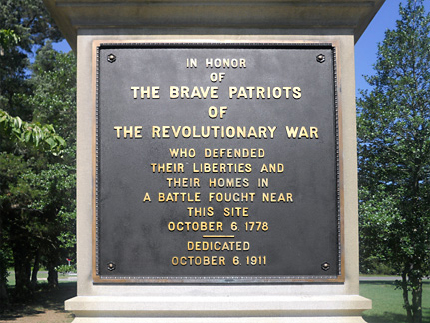
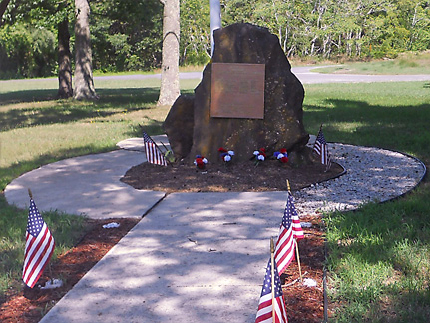
Chestnut Neck Battle Monument
Route 9 and Old New York Rd.
Map / Directions to the Chestnut Neck Battle Monument
Map / Directions to all Port Republic Revolutionary War Sites
THE BATTLE OF CHESTNUT NECK - OCTOBER 6, 1778 [1]
Background - The Privateers, and the Village of Chestnut Neck
The term Privateer refers to a private individual who received a government commission (known as "letters of Marque") to attack and seize enemy ships. During most of the Revolutionary War, the British were in control of New York City, and therefore there was much British shipping traffic in the waters around New Jersey. Many American privateers operated in this area, preying on British merchant ships.
Chestnut Neck was a village on the Little Egg Harbor River (now called Mullica River) making up what is now the northern part of Port Republic. The village's location on the river with access to the Atlantic Ocean made it an important shipping harbor before the Revolutionary War. When the war came, those same good harbor facilities made it a haven for the privateers. They would bring their captured British vessels to Chestnut Neck, where some of the goods would be taken to be used by the Continental (American) Army, and the rest would be sold. Some of the captured vessels would be converted into additional privateer boats. [2]
Prelude to the Battle - Late September - October 5, 1778
The privateers seized many British vessels, which had a negative effect on the British, while helping the American side. By late September 1778, British Commander General Henry Clinton decided to take serious action against the privateers. During the last week of September, a fleet of nine ships was assembled to sail from New York City down the New Jersey coast and make an attack on Chestnut Neck.
The ships headed out towards Chestnut Neck at about midnight on September 30. The naval officer in charge of the ships was named Henry Collins. [3] On board were 400 British soldiers who were under the command of Captain Patrick Ferguson. [4]
The ships of the 1700's which operated by sails were much more affected by winds and weather than modern fuel-powered vessels. Also, they did not have the extended and reasonably accurate weather reports we have today based on satellite information and other modern technology. Therefore, they could not easily anticipate upcoming changes in weather conditions. These factors would come into play as the ships headed towards Chestnut Neck.
Their trip started off well, as the wind was with them. But by the next day, the winds changed directions and a storm began. As a result, it took them over four days to travel just 77 ½ nautical miles to the bay outside the Little Egg Harbor River, known as the Great Bay. When they finally arrived in the Great Bay on October 5, the weather caused further complications. Their larger ships were unable to enter the bay due to the winds. Therefore, the soldiers were loaded into the smaller boats to head into the bay and then up the river to Chestnut Neck.
The Battle of Chestnut Neck and the Destruction of the Village - October 6, 1778
A small fort had been constructed on the river by the Americans to protect Chestnut Neck. [5] The fort was manned by militiamen, but it was not equipped with cannons. They were unable to put up much resistance against the British forces who opened cannon fire on the fort from their ships, and then came ashore attacking and driving the American forces from the fort into the woods.
The British destroyed several privateer ships they found, as well as the houses in the village. The British would have caused more damage, but their delayed arrival caused by the weather had given the inhabitants of Chestnut Neck time to prepare. A number of privateer vessels were sent out to the ocean or miles upriver to a spot known as the Forks, and the locals had time to remove valuables from the houses and hide them in the woods.
The British had hoped to sail farther up river to capture the privateer vessels which had been moved to the Forks. However, they had received word that American military forces were on their way to Chestnut Neck, and they decided that it was safer to instead leave the river and return to the bay, which they did at midday on October 7. The British ships intended to leave immediately and head back to New York, but they were again deterred by weather conditions. Wind and water conditions kept the British in the bay for another fifteen days.
American forces under the command of General Casimir Pulaski arrived in the area on October 8, too late to defend the village of Chestnut Neck. They made camp about five miles northeast from here, in what is now Little Egg Harbor Township. On October 15, two hundred British troops came ashore and made a surprise attack on a group of Pulaski's troops, in what is known as the Affair at Little Egg Harbor. See the Little Egg Harbor Township page for details.
The Monument and the Park
The fifty-foot tall Battle of Chestnut Neck Monument was dedicated at an unveiling ceremony on October 6, 1911, the 133rd anniversary of the battle. It was erected through the efforts of the General Lafayette Chapter of the Daughters of the American Revolution. [6] The soldier on top faces towards the river, as if standing watch for enemy ships. The monument stands inside a park which also displays items believed to be from ships sunk during the battle - an anchor and a ship's rib. [7]
There are also two informational boulder plaques in the park which were erected by the Col. Richard Somers Chapter Sons of the American Revolution. The information on these two plaques appears below:
| CAPTAINS | SHIPS |
| Samuel Allen | Unknown |
| John Badcock | Rainbow |
| John Baudouine | Governor Clinton |
| Samuel Bigelow | Whaleboat |
| Andrew Brown | Endeavour |
| Nathan Brown | Jack |
| Samuel Brown | Civil Usage |
| Joseph Edwards | Luck & Fortune |
| Rufus Gardner | Enterprize |
| Baker Hendrick | Charming Betsey |
| Adam Hyler | Revenge |
| Samuel Ingersoll | Santipe |
| Nathan Jackson | Greyhound |
| Nicholas Keen | Friendship |
| James Leach | Happy Return |
| William Marun | Enterprise |
| Thomas Quigley | Lively |
| Micajah Smith * | Sly |
| Timothy Shaler | Chance |
| Robert Snell | Rattlesnake |
| Andrew Steelman | Alligator |
| David Stevens | Chance |
| Joshua Studson | Gunboat |
| Enoch Stillwell | Hawk |
| Aaron Swain | Revenge |
| Yelverton Taylor | Comet |
| William Treen | Unity |
| Ebenezer Tucker | Kitty |
| Teunis Voorhees | Revenge |
| John Wanton | General Washington |
| Lambert Wickes * * | Reprisal |
| Amos Willits | Armed Boat |
| Enoch Willits | Unknown |
| Hope Willits | Luck & Fortune |
* See the Micajah Smith's Meeting House Site and Cemetery entry below
**
See the Wildwood Crest page for information about the Battle of Turtle Gut Inlet, which involved Lambert Wickes and the Reprisal.
Men of the 3rd Battalion, Gloucester County
Militia
who were Killed, Wounded, or Taken
Prisoner
During the Revolutionary War.
Commanded by Col. Richard Somers [9]
Killed In Action
Private Forrest Bellangy (Killed at the Second Battle of Trenton)
Private John Cain (Murdered while POW in Tuckerton)
Lt. John Lucas (Killed in post-Red Bank Fight)
Captain Henry Snell (Killed by Friendly Fire at Long Beach Island)
Captain Andrew Steelman (Murdered at Long Beach Island)
3 Other Unnamed Men (Killed at Petticoat Bridge / Mt. Holly)
Wounded in Action
Major Elijah Clark (Wounded at the Second Battle of Trenton)
Private Stephen Ford (Wounded at Petticoat Bridge)
Private Hugh Jones (Wounded in post-Red Bank fight)
Lt. John Lucas(Wounded at Petticoat Bridge)
Lt. David Scull (Wounded at Long Beach Island)
Private John Steelman (Wounded on Cumberland County Patrol)
Private John Thomas (Wounded at Tuckerton)
Lt. John Tilton (Wounded in post-Red Bank fight)
3 Unnamed Men (Wounded at raid at John Steelman's House in Absecon)
Taken Prisoner of War
Private David Denike (Taken in Post-Chestnut Neck Period - Exchanged)
Private Benjamin Endicott (Taken in skirmish near Camden - Exchanged)
Private John Ingersoll (Taken in Post-Chestnut Neck Period - Exchanged)
Private James Leeds (Taken in Absecon Raid - Escaped)
Private Patrick Mccollum (Taken in skirmish near Camden - Exchanged)
Captain Enoch Willits (Taken in Cape May raid - Died in Prison)
4 other Unnamed men (2 post-Chestnut Neck, 2 at Camden - Exchanged)
Note: this area was part of Gloucester County at the time of the Revolutionary War, which is why these men served in the Gloucester County militia. Atlantic County did not exist at that time. It was created from part of Gloucester County in 1837, fifty-four years after the end of the Revolutionary War. [10]
See the Somers Point page for several historic sites associated with Colonel Richard Somers.



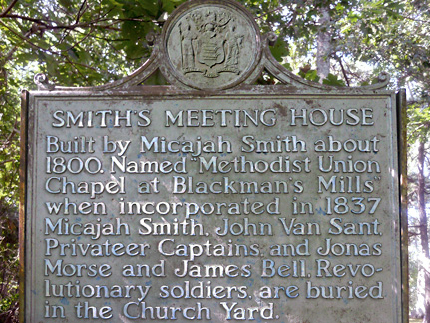

Smith's Meeting House Site and Cemetery
Main St. (Route 575) and Park Ave.
Map / Directions to the Smith's Meeting House Site and Cemetery
Map / Directions to all Port Republic Revolutionary War Sites
Micajah Smith (1742 - 1807) was a privateer during the Revolutionary War; he was the captain of a ship name Sly. He built a Methodist church at this site circa 1800. [11] The church no longer stands, but its small cemetery still remains. Smith is buried here along with several other Revolutionary War veterans: [12]
James Bell
(1755-1831)
Jonas Morse
(1752-1824)
John Van Sant
Privateer Captain
(1726 -1820)



Clark Burying Ground
Indian Cabin Rd.
Map / Directions to the Clark Burying Ground
Map / Directions to all Port Republic Revolutionary War Sites
Three men who served as privates in the Gloucester County Militia during the Revolutionary War are buried here: [13]
Adrial Clark
Jan. 5, 1759 - Nov. 15, 1828
Parker Clark
1766 - Jan. 15, 1844
Thomas Clark
Oct. 7, 1758 - Mar. 28, 1827
As noted above, this area was part of Gloucester County at the time of the Revolutionary War, which is why these men served in the Gloucester County militia. Atlantic County was created from part of Gloucester County in 1837, fifty-four years after the Revolutionary War ended. [14]

1. ^ Information about the Battle of Chestnut Neck was drawn from a number of primary and secondary sources, including:
• Franklin W. Kemp, A Nest of Rebel Pirates (Egg Harbor City, NJ: The Laureate Press, 1966)
▸ This book contains a great deal of information about the Battle of Chestnut Neck, including sections which focus on individual elements and people associated with the battle. It is well sourced and footnoted, and is recommended to those who would like to study the Battle of Chestnut Neck in detail.
The book has an appendix which reprints documents related to the incident, including the following first-hand accounts from British officers:
~ Report from Commander Henry Collins to Rear Admiral Gambler, Zebra, in Little Egg Harbour, October 9, 1778
~ Report of Captain Patrick Ferguson of the 70th Regiment to his Excellency, Sir Henry Clinton, dated Little Egg Harbour, October 10th [1778]• William S. Stryker, The Affair At Egg Harbor New Jersey October 15, 1778 (Trenton: Naar, Day & Naar, 1894)
Available to be read at Google Books here
▸ Contains an appendix which also reprints the reports form Collins and Ferguson mentioned above.• The Pennsylvania Evening Post, October 9, 1778, reprinted in:
Francis B. Lee, Archives of the State of New Jersey, Second Series, Vol II (Documents Relating to the Revolutionary History of the State of New Jersey / Extracts from American Newspapers relating to New Jersey) (Trenton: John L. Murphy Publishing Company, 1903) pages 472-473
Available to be read at the Internet Archive here• "Expedition to Egg Harbor," New-York Gazette and Weekly Mercury, October 26, 1778, reprinted in:
Francis B. Lee, Archives of the State of New Jersey, Second Series, Vol II (Documents Relating to the Revolutionary History of the State of New Jersey / Extracts from American Newspapers relating to New Jersey) (Trenton: John L. Murphy Publishing Company, 1903) Page 219
Available to be read at the Internet Archive here2. ^ The following newspaper notices from 1778 announce the sale at Chestnut Neck of ships and cargo captured by privateers.
They are all reprinted in:
Francis B. Lee, Archives of the State of New Jersey, Second Series, Vol II (Documents Relating to the Revolutionary History of the State of New Jersey / Extracts from American Newspapers relating to New Jersey) (Trenton: John L. Murphy Publishing Company, 1903)• "To be sold at publick vendue at Chestnut Neck...", New-Jersey Gazette, Vol. 1 No. 39, Sept. 2, 1778
Archives of the State of New Jersey, Second Series, Vol II, Page 402
Available to be read at the Internet Archive here• "To Be Sold, By way of Public Vendue, on Monday the 14th instant..." , The Pennsylvania Packet, September 3, 1778
Archives of the State of New Jersey, Second Series, Vol II, Page 403
Available to be read at the Internet Archive here• "This day, at the house of George Payne, at Chestnut-Neck...", New-Jersey Gazette, Vol. 1, No. 44, Oct. 7, 1778
Archives of the State of New Jersey, Second Series, Vol II, Pages 468 - 469
Available to be read at the Internet Archive here
▸ Note that while this notice ran in the October 7, 1778 edition of the New-Jersey Gazette, it must have been submitted to the newspaper days before. This October 7 auction would not have actually taken place, because the day before was the Battle of Chestnut Neck when the village was destroyed.
3. ^ On page 16 of A Nest of Rebel Pirates, Franklin W. Kemp claims the correct spelling of the Commander's name is "Colins," based on British Admiralty records. However, most accounts of the Battle of Chestnut Neck spell his name as "Collins."
4. ^ The troops consisted of about 300 British soldiers of the 5th Regiment of Foot, and about 100 of the Loyalist 3rd Battalion of New Jersey Volunteers. The Loyalists were Americans who remained loyal to the British and fought on their side in the war.
• Captain Ferguson played a large role in the Affair at Little Egg Harbor, which occurred nine days after the Battle of Chestnut Neck. For more information, including a short bio of Ferguson, see the Little Egg Harbor Township page.
5. ^ The fort was constructed by Richard Wescoat (or Wescott) and Elijah Clark.
Richard Wescoat's gravesite is located in Mays Landing, along with a historic sign honoring his Revolutionary War service, including constructing the fort at Chestnut Neck. See the May's Landing page of this website for more information.
▸ The fort being constructed by Wescoat and Clark is recorded in:
Saturday, September 20, 1777 entry; Votes and Proceedings of the General Assembly of the State of New-Jersey (Burlington: Isaac Collins, 1777) Pages 180-181
Available to be read at the Internet Archive here
▸ Note that while this entry states they had "purchased a Number of Cannon for the Defense of said Port," there were no cannons at the fort at the time of the Battle of Chestnut Neck.
6. ^ Plaque on the base of the Battle of Chestnut Neck Monument
Franklin W. Kemp, A Nest of Rebel Pirates (Egg Harbor City, NJ: The Laureate Press, 1966) page 897. ^ The anchor has a plaque which states that it is "believed to be from a British Merchant ship captured by Privateers and sunk during the Battle of Chestnut Neck, October 6, 1778."
The ship's rib has a plaque which states that it is "thought to have been sunk during the Battle of Chestnut Neck, October 6, 1778. Recovered during extreme low tide, 1971. "8. ^ In Honor of the "Privateers" who Sailed and Fought for American Independence "1776 - 1783'" plaque dedicated by the Col. Richard Somers Chapter Sons of the American Revolution.
9. ^ In Honor of the Men of the 3rd Battalion/ Gloucester County Militia / Col. Richard Somers - Commanding plaque, dedicated May 31, 2014 by the Col. Richard Somers Chapter Sons of the American Revolution.
▸ Note that while the information appears as it does on the plaque, some adjustments to the wording and style have been made to fit the format of this website.10. ^ John F. Snyder, The Story of New Jersey's Civil Boundaries: 1606-1968 (Trenton: Bureau of Geology and Topography, 1969) Page 67
Available as a PDF on the State of New Jersey website here. (Note that although the information is on pages numbered 67 of the document, it is on pages 78 of the PDF file.)11. ^ Atlantic County historic sign, and New Jersey Commission of Historic Sites sign at the site
12. ^ Gravestones and General Lafayette Chapter of the Daughters of the American Revolution markers in the cemetery
13. ^ Information drawn from:
• Gravestones and General Lafayette Chapter of the Sons of the American Revolution markers in the cemetery
• Daughters of the American Revolution Genealogical Research System
Parker Clark is Ancestor #A022600
Thomas Clark is Ancestor # A022710• William S. Stryker, Official Register of the Officers and Men of New Jersey in the Revolutionary War (Trenton: Wm. T. Nicholson & Co., 1872) pages 539-540
Available to be read at Google Books here14. ^ John F. Snyder, The Story of New Jersey's Civil Boundaries: 1606-1968 (Trenton: Bureau of Geology and Topography, 1969) Page 67
Available as a PDF on the State of New Jersey website here. (Note that although the information is on pages numbered 67 of the document, it is on pages 78 of the PDF file.)